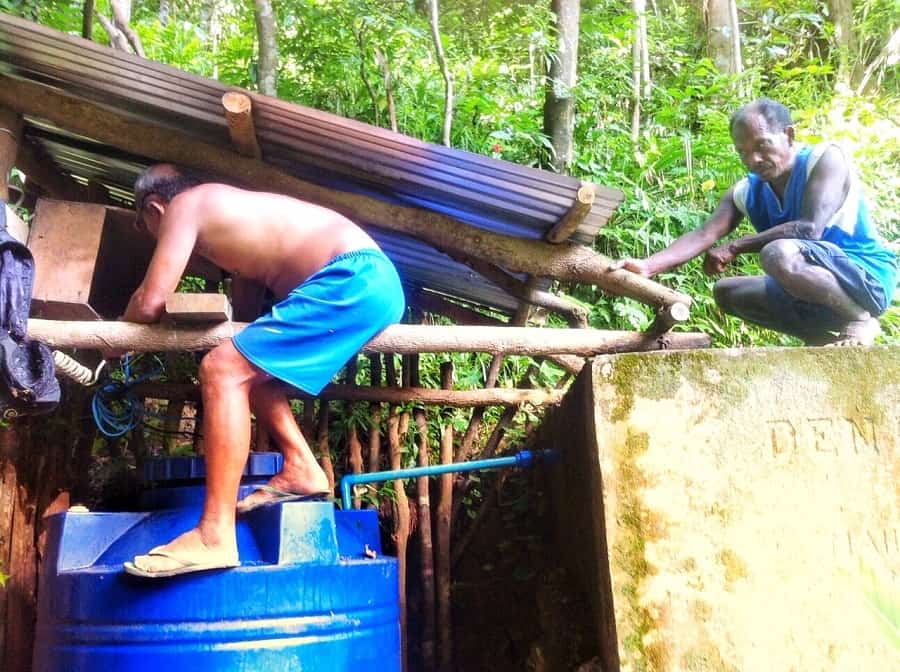Last Updated on October 25, 2024 by Ellen
I heard of the potential pump problem second hand; on-off-on-off-on-off.
That’s the description as relayed by my Philippine rice-farmer friend, Juli, pictured above with me, and Charlie, a member of the local indigenous Ati tribe.
Juli had first been told about the water pump issue by another Ati tribe member. No more info was to be had.
The pump is the centerpiece of the drinking water collection and distribution system we designed for the Ati and began using at the beginning of June here in Malay Aklan, Panay, Philippines.
It eliminates the need for Ati to traverse a long, steep, uneven footpath carrying heavy jugs of drinking water.
Word of the possible pump breakdown put me in a near panic.

Of course, we are here in the Philippines sponsoring rural water system improvements and other Ati community sustainability projects as a result of the COVID-19 crisis – which has temporarily interrupted our leisurely life of early-retired global wandering.
In the four months since installation, the drinking water system has performed well. Aside from a few minor leaks and tweaks to the PVC piping and public spigots, no issues.
In fact, while I initially had concerns about the durability of the pump, tank, and pipe set-up, as time has passed, I have become ever more confident in the engineering and operation.
Each morning, at sunrise, Charlie (the Ati ‘water manager’) manually flicks on the pump from the control box near his nippa hut. The three-quarter-horsepower electric motor kicks on, and in about 20 minutes, 200 gallons of fresh drinking water is sent from the natural spring far below to the hilltop distribution tank right next to Charlie. A built-in electronic float switch shuts the pump down. Charlie resets the system; does it all again in the late afternoon.
Now I had to find Charlie and figure out what was going on. Filled with apprehension, and carrying tools, Juli and I made the 25-minute hike from his rice field home up to the Ati village water tank.
On-off-on-off-on-off… what would cause that?
When we arrived, Charlie confirmed the on-off problem. Further, he said it had happened both that morning and the day before when he activated the pump. And he described the on-off cycle as repeatedly lasting 4 to 5 seconds each. Very odd and inexplicable. And now, the system was completely offline.

A visual check of the electric lines, meter, breaker, and all connections revealed nothing amiss. The pieces and parts are labeled above. We went to the upper control panel and flicked on the pump. Silence.
Normally, when the breaker is switched on, the faint sound of splashing water can be heard almost immediately – as pumped spring water starts to flow into the big concrete holding tank. Now, nothing. More minutes. More silence.
The electric meter hadn’t budged. The heavy-duty tank fill pipe was empty. Water wasn’t moving. The pump wasn’t working.
But we did have power. One of the tools Juli carried up was a primitive electric current tester: a bulb in a socket with two short wires attached. When we touched the wires to the top breaker connections, the light bulb came on.
We sent Charlie down to turn off the lower breaker at the pump itself as we checked and tested the electric meter. Was something loose, wet, corroded? On-off-on-off… everything seemed A-OK.
Once Charlie turned the bottom breaker OFF, and whistled to inform us, we turned the top one ON. Juli and I then walked down to the pump where we now would have full power control using the bottom breaker. (In case you are wondering, the pump is properly grounded.)

The photo above shows Juli with his bag of tools making every possible check of the electrical system (including float switch) – as Charlie looks on. Thank God for Juli too. He has the knowledge, experience, tools, and confidence with wiring and power to do the needed checks. I don’t.
Standard Philippine electric power is 220 volts – not something to be toyed around with. Still, our test results were something of a bad joke. Sometimes the test bulb would light – seconds later it wouldn’t, even though nothing had been changed. Repeatedly, we got differing results, strange… almost like on-off-on-off-on-off. Hmmmm… and we never did get the pump to work during our efforts.
Unable to solve the oddities – and without a voltage meter – we reattached everything at the pump. Juli and Charlie announced they would meet me back up-top after they followed and checked the whole pump electric line by foot on the crazy, steep, jungle hillside.
Back to the top I went. The guys arrived almost at the same time and announced they found no problems with the hillside wire.
Frustrated, puzzled, and with the sun setting we resolved to return the next day with a volt meter, do some more checks, then pull out the whole pump for further testing if necessary.
My heart sank. It meant the convenient water we had been providing the Ati hilltop community would definitely stop until we could figure out a solution. The Ati would again be walking the treacherous footpath down to fill jugs for daily drinking – a huge step backwards.
And to be clear, there is no easy repairing of this pump. It is a factory sealed, submersible unit. We couldn’t safely ‘fix’ it if we wanted. I had ordered and had it sent from the USA. Warranty? Shipping? Time? Uhhgggg! I did curse the pump and maker at various points.
But as my mind raced and I paced and dismayed, Juli did a few more tests with his primitive bulb device. Eventually, he said he wanted to replace the upper breaker itself. He had noticed some evidence of arcing/burning at one connection. Did we have a spare?
Uhhhh… well… there was one in the hen house (another Ati project) that is no longer connected or needed. Great!
We hurried to the hen house, and using my cell phone flashlight, removed the unused 30-amp breaker. Minutes later we had swapped it with the pump control panel breaker.
“OK, turn it on”, I said dejectedly. Suddenly, a splashing sound. I dashed to the big water storage tank. Yes!!! The sound of the pumped water!
That quickly, the pump system was working again. The failed/burned breaker replaced, everything now operating again. A whole afternoon of angst and confusion and disenchantment a quickly fading memory. Juli had saved the day!

Here’s the photo of me, Juli, and Charlie again – after finding and fixing the faulty breaker. Note the satisfied smiles. And let me assure you, under that face mask, I am beaming big with glee!
Even better, as we started our hike back down the mountain, hoping to get back to Juli’s before dark, Ati women and children were gathering with their empty water jugs at the main village filling spigot, collecting drinking water as normal, probably wondering why the delay. I snapped the photo below as we went by. Juli, a father of four himself, proudly watching the pouring.

Juli doesn’t know — he was behind me as we went on — but on our walk back home, tears of joy and thanks soaked my mask.
Even now, I am so relieved and pleased that we were able to keep that water flowing! It may have been the most satisfying moment of my 18 months in this place!
Thanks to Juli, all is well – now a few days later. On-off-on-off-on-off; the Ati drinking supply is definitely ON.
As always, be thankful and generous (like our overseas donors), happy trails & more beer.
Life is NOW!
Thank you for reading, “Pump panic in Ati Kurong Village.”



I love reading your stories of your adventures while waiting out this COVID! God bless you guys for all of your hard work!!